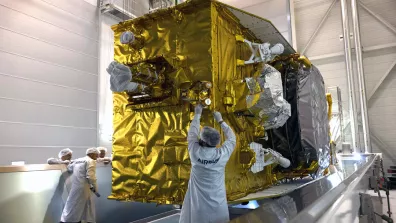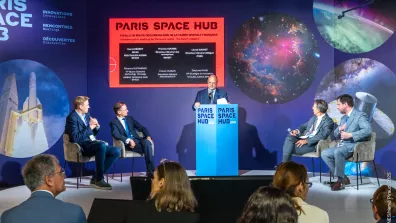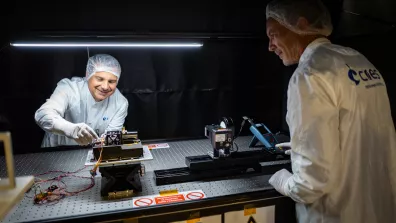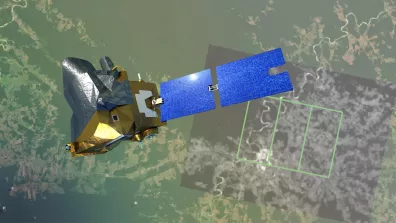A fruitful year for TELEO! CNES, Airbus Defence and Space and the start-up company OGS Technologies have just successfully completed one year of in orbit operations with this “made in France” demonstrator.
The aim of the TELEO demonstration was to validate in orbit the capacity of the French industrial ecosystem to perform very high throughput laser communications from and to the geostationary orbit (36 000 km altitude).
By providing multi-gigabit-per-second class data rates, these experimental links multiply by 10 to 100 the typical throughput compared with current broadband connectivity solutions (space systems relying on radio-frequency technologies).
Laser communications: unrivalled precision
After electrical and digital satellites, CNES is now developing new technological building blocks, including optical links, with and to the benefit of the French industry. Among other advantages? The optical beam is highly directional, making it highly insensitive to interference and jamming. Transmitted from the geostationary orbit at an altitude of 36,000 km, an infrared laser “illuminates” an ground area of just a few hundred meters, compared with tens to thousands of kilometers with traditional radio-frequency solutions!
In orbit: the payload, designed and operated by Airbus France, launched in May 2023 aboard the ARABSAT BADR8 telecommunications satellite. On ground: FrOGS, the CNES optical station located at the Côte d'Azur Observatory, designed and built for CNES by a 100% French industrial consortium (OGS Technologies, Safran Data Systems, Bertin ALPAO, and Airbus).
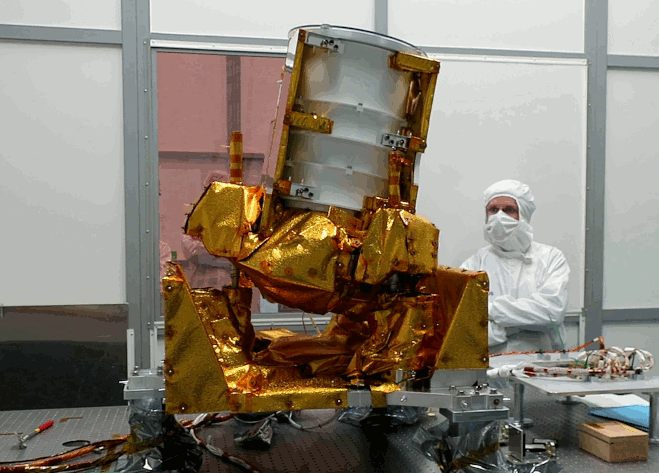
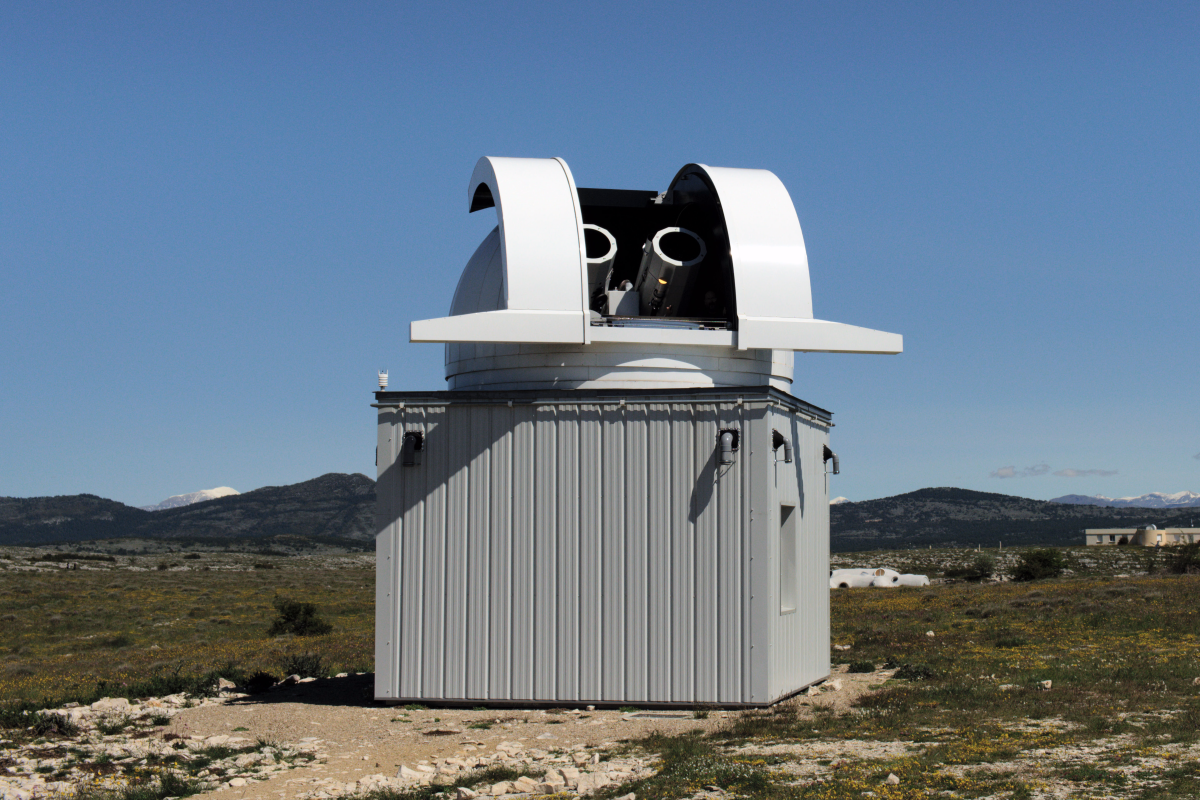
The successful TELEO demonstration, designed and implemented in record time, symbolizes the fruitful cooperation between the French Space Agency, CNES, a space System Prime, Airbus, and a start-up company, OGS Technologies.
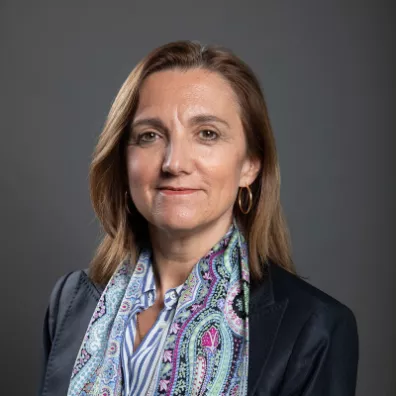
The initial six-month phase focused on the payload's in orbit health check and on the verification of its ability to establish the first very high-speed laser links with the station. Then, the following six months aimed at collecting large volume of cutting edge experimental results. The optical links between TELEO's payload and the FrOGS station made it possible to :
- demonstrate the ability of TELEO's payload to detect and point to the ground station and vice versa (equivalent to aiming a rugby ball over 100 km away!),
- demonstrate the reliability and robustness of TELEO-FrOGS links under a wide range of operational conditions: day and night, close to the sun, under multiple wind and atmospheric conditions, etc,
- demonstrate the ability of optical links to provide bidirectional transmissions at very high data rates (up to 9 Gbps tested in the demonstration), thanks in particular to the robust and industrial adaptive optics techniques introduced in FrOGS (a technique inherited from astronomy, traditionally used to compensate for image distortions caused by turbulence in the Earth's atmosphere),
- create a unique archive of experimental data, not limited to data transmission tests alone, but which will also be of major interest for further industrial and scientific R&D projects.
TELEO and FrOGS key figures
- World first demonstration of an Earth-to-space optical link with a geostationary satellite, enabling bidirectional communications modulated at 10 GigaBauds, with downlink data rates configurable between 750 Mbps and 9 Gbps.
- 22 days of demonstrations involving TELEO and FrOGS
- More than 66 hours of experiment with TELEO and FrOGS, including about 60 hours of active communication
- 500 parameters monitored continuously on board the satellite, and 50 parameters from the FrOGS ground station periodically uploaded to the mission control center.
Towards a new generation of space telecommunications
Introduced as early as 2020 in our roadmap, then prepared by an early phase project led by its initiator and prime contractor Airbus, this demonstration was an opportunity for the French industrial ecosystem to confirm how it masters this disruptive technology. This milestone follows on from the R&D activities supported by CNES on radio frequency technologies, which led to the entry into service in 2023 of the Konnect VHTS satellite, with a capacity of 500 Gigabits per second (Eutelsat).
Optical links between the ground and geostationary orbit will enable the French industrial ecosystem to take a new step forward in terms of satellite broadband connectivity. The TELEO demonstration, and the technological development activities carried out in parallel under our leadership, will promote systems with Terabit-per-second class capacities and new solutions for very high-speed connectivity between isolated sites not served by terrestrial optical fiber.
The success of the demonstration confirms the credibility of these space-based optical technologies. This success should encourage SatCom operators to introduce them in the next generation of satellites that will benefit the general public, whether private or professional.
Thanks to this success together with on-going technological development projects under CNES supervision, the French industry ecosystem is now ready to propose cutting-edge space applications for free space laser communications. Multiplying by 1000 the bandwidth of Earth-Space communications without any risk of jamming, or implementing 10 to 100 Gbps-class point-to-point optical links between ground isolated infrastructures may now become a reality. This in-orbit demonstration could be the first step preparing a potential revolution equivalent to the emergence of optical fiber in terrestrial communication networks!

Several projects for a revolution
Various activities, carried out under our supervision, have fostered the emergence of applications for laser links.
On the one hand, the TELEO demonstration was developed and implemented to facilitate the introduction of this breakthrough technology, under the responsibility of Airbus and as part of our DYSCO project.
The FrOGS station, for its part, was designed under the responsibility of OGS Technologies for multiple uses (see box). For its configuration dedicated to TELEO, it benefited from the first technological bricks prototyped as part of the “France Relance” CO-OP (COmmunication Optique) project, which we are piloting, and which is carried out by a consortium of 17 partners coordinated by Airbus.
FrOGS, a multipurpose tool
FrOGS, the baseline station of the TELEO demonstration, is the result of a strong partnership between CNES and several French industrial partners, including OGS Technologies, a startup company founded in 2020. OGS Technologies has provided the station design and led its manufacturing, assembly and validation. The station is thought as a multipurpose tool allowing optical links with geostationary satellites like forTELEO but also with low orbit satellites for data transmission, ranging or quantum key distribution (QKD). In this perspective, the CNES/Airbus France project CO3D will allow in 2025 the first optical communications between a low Earth orbit satellite and the FrOGS station, in a low orbit “Direct-To-Earth” dedicated configuration. The specific TELEO version is a precursor for the future commercial “Terabit” optical ground stations proposed by a new French industrial consortium.
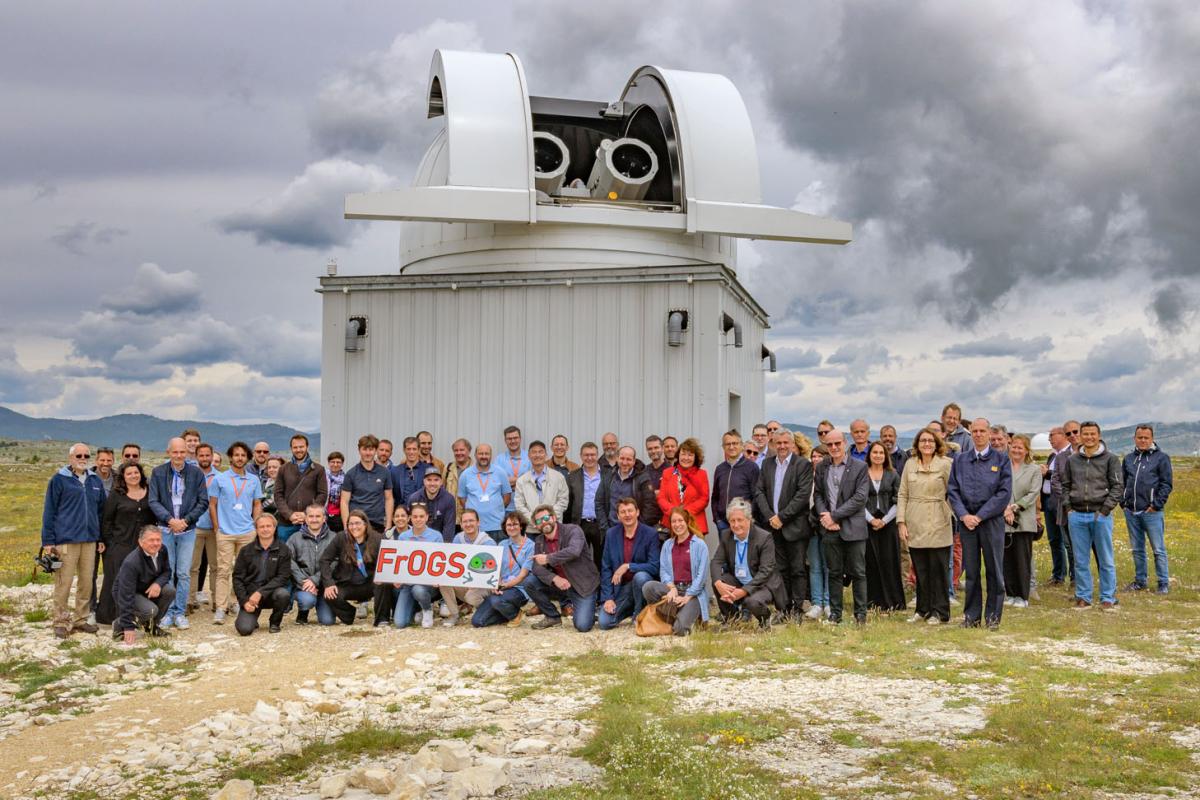
I am very proud of our young team who provided CNES with a new optical ground station (OGS) in a very short time to meet the needs of the TELEO demonstration. The performances achieved by this new OGS is at the best level in the world. The reliability and robustness of the realized optical links is very promising for future commercial services based on this emerging technology and place today OGS Technologies as a leader in the deployment of optical ground stations.

Through the FrOGS project, CNES demonstrates its capacity for innovation while providing a deep technical expertise to work hand in hand with a plural and dynamic industrial ecosystem on the field of optical communications. This collaboration makes France a leading nation for the next-gen communication technologies.

The aim of the CO-OP project is to prepare the French consortium involved to propose future operational systems for two-way optical telecommunications with satellites in geostationary orbit. It should benefit directly from the experimental data collected as part of the TELEO demonstration.


